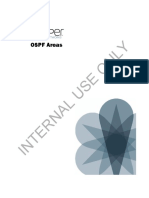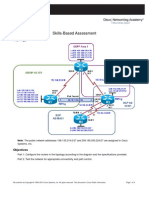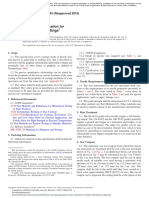0 ratings0% found this document useful (0 votes)
1K viewsOSPF Definition: Open Shortest Path First (OSPF), Is A Routing
OSPF Definition: Open Shortest Path First (OSPF), Is A Routing
Uploaded by
Baah geooffrey JnrOpen Shortest Path First (OSPF) is a routing protocol that uses the Shortest Path First (SPF) algorithm to determine the best route between any two points on a network. It was developed by the IETF as an interior gateway protocol to replace RIP within larger networks. OSPF divides large networks into hierarchical areas to reduce routing traffic and table sizes. It quickly propagates changes by sending link-state advertisements whenever network connections or metrics change.
Copyright:
Attribution Non-Commercial (BY-NC)
Available Formats
Download as PPT, PDF, TXT or read online from Scribd
OSPF Definition: Open Shortest Path First (OSPF), Is A Routing
OSPF Definition: Open Shortest Path First (OSPF), Is A Routing
Uploaded by
Baah geooffrey Jnr0 ratings0% found this document useful (0 votes)
1K views14 pagesOpen Shortest Path First (OSPF) is a routing protocol that uses the Shortest Path First (SPF) algorithm to determine the best route between any two points on a network. It was developed by the IETF as an interior gateway protocol to replace RIP within larger networks. OSPF divides large networks into hierarchical areas to reduce routing traffic and table sizes. It quickly propagates changes by sending link-state advertisements whenever network connections or metrics change.
Original Description:
is all about netwwork protocols(rules govern each network technology)
Original Title
OSPF Definition: Open Shortest Path First (OSPF), Is a Routing
Copyright
© Attribution Non-Commercial (BY-NC)
Available Formats
PPT, PDF, TXT or read online from Scribd
Share this document
Did you find this document useful?
Is this content inappropriate?
Open Shortest Path First (OSPF) is a routing protocol that uses the Shortest Path First (SPF) algorithm to determine the best route between any two points on a network. It was developed by the IETF as an interior gateway protocol to replace RIP within larger networks. OSPF divides large networks into hierarchical areas to reduce routing traffic and table sizes. It quickly propagates changes by sending link-state advertisements whenever network connections or metrics change.
Copyright:
Attribution Non-Commercial (BY-NC)
Available Formats
Download as PPT, PDF, TXT or read online from Scribd
Download as ppt, pdf, or txt
0 ratings0% found this document useful (0 votes)
1K views14 pagesOSPF Definition: Open Shortest Path First (OSPF), Is A Routing
OSPF Definition: Open Shortest Path First (OSPF), Is A Routing
Uploaded by
Baah geooffrey JnrOpen Shortest Path First (OSPF) is a routing protocol that uses the Shortest Path First (SPF) algorithm to determine the best route between any two points on a network. It was developed by the IETF as an interior gateway protocol to replace RIP within larger networks. OSPF divides large networks into hierarchical areas to reduce routing traffic and table sizes. It quickly propagates changes by sending link-state advertisements whenever network connections or metrics change.
Copyright:
Attribution Non-Commercial (BY-NC)
Available Formats
Download as PPT, PDF, TXT or read online from Scribd
Download as ppt, pdf, or txt
You are on page 1of 14
OSPF Definition:
Open Shortest Path First (OSPF), is a
routing protocol used to determine the
correct route for packets within IP
networks. It was designed by the
Internet Engineering Task Force to
serve as an Interior Gateway Protocol
replacing RIP.
BACKGROUND
Open Shortest Path First (OSPF) is a routing
protocol developed for Internet Protocol (IP)
networks by the Interior Gateway Protocol
(IGP) working group of the Internet
Engineering Task Force (IETF). The working
group was formed in 1988 to design an IGP
based on the Shortest Path First (SPF)
algorithm for use in the Internet. Similar to
the Interior Gateway Routing Protocol (IGRP),
OSPF was created because in the mid-1980s,
the Routing Information Protocol (RIP) was
increasingly incapable of serving large,
heterogeneous internetworks.
OSPF was derived from several research
efforts, including Bolt, Beranek, and
Newman's (BBN's) SPF algorithm developed
in 1978 for the ARPANET (a landmark packet-
switching network developed in the early
1970s by BBN), and Dr. Radia Perlman's
research on fault-tolerant broadcasting of
routing information (1988).
OSPF has two primary characteristics. The
first is that the protocol is open, which means
that its specification is in the public domain.
The OSPF specification is published as
Request For Comments (RFC). The second
principal characteristic is that OSPF is based
on the SPF algorithm, which sometimes is
referred to as the Dijkstra algorithm, named
for the person credited with its creation.
OSPF is a link-state routing protocol that calls
for the sending of link-state advertisements
(LSAs) to all other routers within the same
hierarchical area. Information on attached
interfaces, metrics used, and other variables
is included in OSPF LSAs. As OSPF routers
accumulate link-state information, they use
the SPF algorithm to calculate the shortest
path to each node.
ROUTING HIERARCHY
Unlike RIP, OSPF can operate within a hierarchy. The
largest entity within the hierarchy is the autonomous
system (AS), which is a collection of networks under a
common administration that share a common routing
strategy. OSPF is an intra-AS (interior gateway) routing
protocol, although it is capable of receiving routes
from and sending routes to other ASs.
An AS can be divided into a number of areas, which
are groups of contiguous networks and attached
hosts. Routers with multiple interfaces can participate
in multiple areas. These routers, which are called Area
Border Routers, maintain separate topological
databases for each area.
A topological database is essentially an
overall picture of networks in relationship to
routers. The topological database contains
the collection of LSAs received from all
routers in the same area. Because routers
within the same area share the same
information, they have identical topological
databases.
An area's topology is invisible to entities
outside the area. By keeping area topologies
separate, OSPF passes less routing traffic
than it would if the AS were not partitioned.
Area partitioning creates two different types
of OSPF routing, depending on whether the
source and the destination are in the same or
different areas. Intra-area routing occurs
when the source and destination are in the
same area; inter-area routing occurs when
they are in different areas.
Backbone area
An OSPF backbone is responsible for distributing
routing information between areas. The backbone
area is also known as area 0 or area 0.0.0.0
It forms the core of an OSPF network. All other
areas are connected to it, and inter-area routing
happens via routers connected to the backbone
area and to their own associated areas
It consists of all Area Border Routers, networks
not wholly contained in any area, and their
attached routers. Figure 46-1 shows an example of
an internetwork with several areas.
Figure 46-1 An OSPF AS Consists of Multiple
Areas Linked by Routers
SPF ALGORITHM
The Shortest Path First (SPF) routing algorithm is the
basis for OSPF operations. When an SPF router is powered
up, it initializes its routing-protocol data structures and
then waits for indications from lower-layer protocols that
its interfaces are functional.
After a router is assured that its interfaces are
functioning, it uses the OSPF Hello protocol to acquire
neighbors, which are routers with interfaces to a common
network. The router sends hello packets to its neighbors
and receives their hello packets. In addition to helping
acquire neighbors, hello packets also act as keep alives to
let routers know that other routers are still functional
ADVANTAGES OF OSPF:
Changes in an OSPF network are propagated
quickly.
OSPF is heirarchical, using area 0 as the top of
the heirarchy
Using areas, OSPF networks can be logically
segmented to decrease the size of routing
tables. Table size can be further reduced by
using route summarization.
OSPF is an open standard, not related to any
particular vendor.
After initialization, OSPF only sends updates on
routing table sections which have changed, it
does not send the entire routing table.
DISADVANTAGES OF OSPF:
OSPF is very processor intensive.
OSPF maintains multiple copies of routing
information, increasing the amount of
memory needed.
OSPF is not as easy to learn as some other
protocols.
In the case where an entire network is
running OSPF, and one link within it is
"bouncing" every few seconds, OSPF updates
would dominate the network by informing
every other router every time the link
changed state (I've done this).
You might also like
- Caterpillar d8k Parts BookDocument20 pagesCaterpillar d8k Parts BookHassie100% (68)
- Birth PDFDocument8 pagesBirth PDFspcbanking100% (4)
- IP Routing Protocols All-in-one: OSPF EIGRP IS-IS BGP Hands-on LabsFrom EverandIP Routing Protocols All-in-one: OSPF EIGRP IS-IS BGP Hands-on LabsNo ratings yet
- Jncie Ent SampleDocument26 pagesJncie Ent SamplerohanxelnagaNo ratings yet
- BRKSPG 2904 PDFDocument168 pagesBRKSPG 2904 PDFTakisNo ratings yet
- Alcatel-Lucent Service Routing Architect (SRA) Self-Study Guide: Preparing for the BGP, VPRN and Multicast ExamsFrom EverandAlcatel-Lucent Service Routing Architect (SRA) Self-Study Guide: Preparing for the BGP, VPRN and Multicast ExamsNo ratings yet
- Project Dissertation ON KFC'S Operation StrategiesDocument32 pagesProject Dissertation ON KFC'S Operation StrategiesTvNo ratings yet
- OSPF Routing FundamentalsDocument4 pagesOSPF Routing FundamentalsAkhilesh KumarNo ratings yet
- Versatile Routing and Services with BGP: Understanding and Implementing BGP in SR-OSFrom EverandVersatile Routing and Services with BGP: Understanding and Implementing BGP in SR-OSNo ratings yet
- In Depth Guide to IS-IS Routing: Learn Intermediate System to Intermediate System Routing from scratchFrom EverandIn Depth Guide to IS-IS Routing: Learn Intermediate System to Intermediate System Routing from scratchNo ratings yet
- LEARN MPLS FROM SCRATCH PART-A: A Beginner's Guide to Next Level of NetworkingFrom EverandLEARN MPLS FROM SCRATCH PART-A: A Beginner's Guide to Next Level of NetworkingNo ratings yet
- Isis Design GuideDocument37 pagesIsis Design GuideBao NguyenNo ratings yet
- OSPF - Open Shortest Path FirstDocument28 pagesOSPF - Open Shortest Path FirstsatyamgNo ratings yet
- Ethernet: Distributed Packet Switching For Local Computer Networks - Robert M. MetcalfeDocument10 pagesEthernet: Distributed Packet Switching For Local Computer Networks - Robert M. MetcalfeNeeta GuptaNo ratings yet
- B Cgnat Cg60xasr9k PDFDocument200 pagesB Cgnat Cg60xasr9k PDFMarco López ZeledónNo ratings yet
- IEATC-SPv3 Part 04 MPLSDocument15 pagesIEATC-SPv3 Part 04 MPLSUmair AlamNo ratings yet
- MPLS Configuration Guide sr8800Document410 pagesMPLS Configuration Guide sr8800kmadNo ratings yet
- MPLS TeDocument116 pagesMPLS TeAlisamiirNo ratings yet
- 4 MPLS TE Signaling Protocols ISSUE1.00Document39 pages4 MPLS TE Signaling Protocols ISSUE1.00Randy DookheranNo ratings yet
- CCIE R&S Lab Blueprint v4Document24 pagesCCIE R&S Lab Blueprint v4Ehsan YazdaniNo ratings yet
- Hari Krishna Raju Kanekal Nomus Comm-SystemsDocument155 pagesHari Krishna Raju Kanekal Nomus Comm-Systemsharikrishna242424No ratings yet
- Ixnetwork: Multi-Protocol Visibility With Port Drill-Down and ControlDocument27 pagesIxnetwork: Multi-Protocol Visibility With Port Drill-Down and Controlhuzvn82_622938820No ratings yet
- Mpls Study NotesDocument26 pagesMpls Study NotesFlorea Dan MihaiNo ratings yet
- Cisco IWAN Lab GuideDocument152 pagesCisco IWAN Lab GuidejoseivanvilelaNo ratings yet
- APRICOT2014 - IsIS Fundamentals and TroubleshootingDocument110 pagesAPRICOT2014 - IsIS Fundamentals and TroubleshootingDigonto OniNo ratings yet
- Vagish Mpls - TutorialDocument150 pagesVagish Mpls - TutorialRohanNo ratings yet
- Ospf AreasDocument27 pagesOspf AreasSon Vu TruongNo ratings yet
- Traffic EngineeringDocument88 pagesTraffic Engineeringhem777No ratings yet
- BRKMPL-1261 - IP Multicast - Concepts, Design and Troubleshooting (2016 Melbourne) - 90 MinsDocument100 pagesBRKMPL-1261 - IP Multicast - Concepts, Design and Troubleshooting (2016 Melbourne) - 90 Minshola amigoNo ratings yet
- B Cisco Nexus 7000 Series NX-OS Fundamentals Configuration Guide Release 6.xDocument144 pagesB Cisco Nexus 7000 Series NX-OS Fundamentals Configuration Guide Release 6.xStéphane KenthorNo ratings yet
- MPLS Tutorial SlidesDocument397 pagesMPLS Tutorial Slidescesarmg182No ratings yet
- MPLS Lab ScenarioDocument13 pagesMPLS Lab ScenarioRasyidi UsmanNo ratings yet
- Mpls Layer 3 VPN Pe-Ce Ospf Sham LinkDocument9 pagesMpls Layer 3 VPN Pe-Ce Ospf Sham LinkEmad MohamedNo ratings yet
- CSPFDocument38 pagesCSPFNhan BienNo ratings yet
- Juniper l2 Mpls VPNDocument37 pagesJuniper l2 Mpls VPNovidiu0702No ratings yet
- FGT Overview and DesignDocument11 pagesFGT Overview and DesignUmAiR ANo ratings yet
- Menog4 Isis TutorialDocument80 pagesMenog4 Isis TutorialarunascarletNo ratings yet
- SRX 345Document150 pagesSRX 345i87sanNo ratings yet
- Metro EthernetDocument275 pagesMetro Ethernetolam batorNo ratings yet
- Introduction To MPLS: Steve Smith Systems EngineerDocument72 pagesIntroduction To MPLS: Steve Smith Systems EngineerKishore Reddy KandiNo ratings yet
- TW QFabric TrafficFlowsDocument82 pagesTW QFabric TrafficFlowsAlaa Al-saggafNo ratings yet
- Ccnpv6 Route SbaDocument4 pagesCcnpv6 Route SbaAtilio Alexander100% (1)
- ZXR10-BC-En-OSPF Protocol Principle and Configuration (OSPF Protocol Principle) - 1 51-201309Document51 pagesZXR10-BC-En-OSPF Protocol Principle and Configuration (OSPF Protocol Principle) - 1 51-201309ghee17No ratings yet
- Expertise On MPLS Router Dev / Sustenance/TestingDocument11 pagesExpertise On MPLS Router Dev / Sustenance/TestingAvnish ShrivastavaNo ratings yet
- BGP Route Filtering - Access Lists Vs Prefix Lists - Networks Baseline - Cisco Engineers LiveDocument20 pagesBGP Route Filtering - Access Lists Vs Prefix Lists - Networks Baseline - Cisco Engineers LiveMatt CarterNo ratings yet
- Installing Virl On Vmware Player Workstation FusionDocument4 pagesInstalling Virl On Vmware Player Workstation FusionEric ZhangNo ratings yet
- SRX HA Deployment GuideDocument35 pagesSRX HA Deployment GuideCraig NetsNo ratings yet
- MPLS OverviewDocument61 pagesMPLS OverviewprodigynaveenNo ratings yet
- HLD VF-MAN-Refresh v0 6Document82 pagesHLD VF-MAN-Refresh v0 6Tomás Villalba LopezNo ratings yet
- CCIE Data Center v3 Learning MatrixDocument17 pagesCCIE Data Center v3 Learning MatrixayazNo ratings yet
- 04 MPLS Te PDFDocument69 pages04 MPLS Te PDFlamvan tuNo ratings yet
- Cisco XR RoutingDocument604 pagesCisco XR RoutingedmartzNo ratings yet
- CCIE Day Practice Lab 2Document4 pagesCCIE Day Practice Lab 2Manuel Huertas HonoresNo ratings yet
- Protocol SpecificationsDocument15 pagesProtocol SpecificationsPankaj GargNo ratings yet
- (Cisco Press Core Series) Beau Williamson-Developing IP Multicast Networks. Volume 1-Cisco Press (1999)Document66 pages(Cisco Press Core Series) Beau Williamson-Developing IP Multicast Networks. Volume 1-Cisco Press (1999)Mares MarianNo ratings yet
- Routing ProtocolDocument24 pagesRouting Protocolgomathisankar.v1978No ratings yet
- Topology IOU Narbik RSv5Document4 pagesTopology IOU Narbik RSv5Davi Sadaseeven SaminadenNo ratings yet
- MPLS-Enabled Applications: Emerging Developments and New TechnologiesFrom EverandMPLS-Enabled Applications: Emerging Developments and New TechnologiesRating: 4 out of 5 stars4/5 (4)
- Session Initiation Protocol SIP A Clear and Concise ReferenceFrom EverandSession Initiation Protocol SIP A Clear and Concise ReferenceNo ratings yet
- Adjectives With Ing and Ed WorksheetDocument4 pagesAdjectives With Ing and Ed WorksheetIván Rugel CoronelNo ratings yet
- Install Top Win 7 PDFDocument9 pagesInstall Top Win 7 PDFMehedi HasanNo ratings yet
- Photolithography: Innovative Products For Semiconductor ProcessesDocument50 pagesPhotolithography: Innovative Products For Semiconductor ProcessesGary Ryan DonovanNo ratings yet
- Letter of IntentDocument2 pagesLetter of IntentRic Napus0% (1)
- Androidhive - Info-Android Getting Started With Material DesignDocument35 pagesAndroidhive - Info-Android Getting Started With Material DesignMahesh CeeNo ratings yet
- Why Governments Intervene in Exchange Rate MarketsDocument6 pagesWhy Governments Intervene in Exchange Rate MarketsSyed TajbirNo ratings yet
- Jurisdiction - CFLDocument80 pagesJurisdiction - CFLanailabucaNo ratings yet
- ABI High Voltage Engineering and Testing 3rd Edition PDFDocument1 pageABI High Voltage Engineering and Testing 3rd Edition PDFKannan VellasamyNo ratings yet
- Java Servlets 110317050338 Phpapp01 PDFDocument57 pagesJava Servlets 110317050338 Phpapp01 PDFsakshamNo ratings yet
- PRX127 Data SheetDocument8 pagesPRX127 Data Sheettomgreen2011No ratings yet
- Society, Law and EthicsDocument1 pageSociety, Law and EthicsTonni SarkarNo ratings yet
- Ductile Iron Castings: Standard Specification ForDocument6 pagesDuctile Iron Castings: Standard Specification ForLuis F. LoachamínNo ratings yet
- This Paper Is Not To Be Removed From The Examination HallDocument55 pagesThis Paper Is Not To Be Removed From The Examination HallSithmi HimashaNo ratings yet
- Procedural Matters ANDREA FRASERDocument5 pagesProcedural Matters ANDREA FRASERAndré GuedesNo ratings yet
- P92-5522 Harness - 07-505 H.arapaDocument22 pagesP92-5522 Harness - 07-505 H.arapaEdwitar SGNo ratings yet
- Tender SpecificationsDocument13 pagesTender SpecificationsRizwan Alam SiddiquiNo ratings yet
- Air Courier ServicesDocument58 pagesAir Courier ServicesSyed Jaffar Raza RazaNo ratings yet
- Attachment 1Document5 pagesAttachment 1You NichNo ratings yet
- QuestionsDocument5 pagesQuestionsjupudiguptaNo ratings yet
- History of SbiDocument1 pageHistory of SbiSNEHA MARIYAM VARGHESE SIM 16-18No ratings yet
- 2.battery SizingDocument14 pages2.battery SizingPrabhash Verma0% (1)
- Isuzu DieselDocument25 pagesIsuzu DieselJulian Arcila ValenciaNo ratings yet
- Slope Stabilization Using Micropiles - R0 - JCSDocument15 pagesSlope Stabilization Using Micropiles - R0 - JCSSushma AnanthNo ratings yet
- Form Maintenance-Checklist DailyDocument15 pagesForm Maintenance-Checklist DailyRomly MechNo ratings yet
- DigoxinDocument18 pagesDigoxinApril Mergelle LapuzNo ratings yet
- Investigation of High-Speed Milling and High Efficiency Milling of Ti6Al4VDocument7 pagesInvestigation of High-Speed Milling and High Efficiency Milling of Ti6Al4VIJAERS JOURNALNo ratings yet
- Electrochemistry ECAFM Research Solutions - DS097-RevA0Document2 pagesElectrochemistry ECAFM Research Solutions - DS097-RevA0Fabien CazesNo ratings yet

























































































